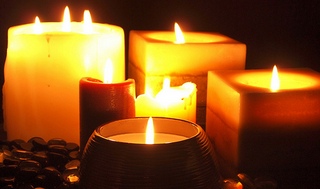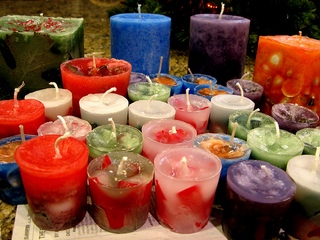|
Homemade Candles:
|
 |
For safety reasons, an indirect source of heat is best for melting wax. We used a large coffee can with water in it as the base of our homemade double boiler and soup cans in which to melt the individual colors and scents of wax. The can method also provides a convenient way to store different types of leftover wax, as cans are easy to come by when you need more. A dedicated double boiler or a small pot inside a larger pot would work as well. I don't recommend using pots that you eat out of, as they can be difficult to clean when you are finished.
There are several different types of wax you can use. Paraffin wax is made from petroleum, the least expensive and easiest to find. It is readily available in craft stores and in canning supply areas (under the name of Gulf Wax). If you wish to make a more environmentally friendly candle, try wax derived from soy, palm, bayberry, or beeswax. These waxes are very popular for making candles due to their sweet smelling scents and solid burning characteristics. Pure soy wax is becoming more widely available, but is relatively soft. It works great in container candles, but isn't very good for making tapers or pillar candles. You can compensate for that problem by blending soy wax with paraffin or hardening additives. Soy wax burns slower than paraffin wax, making the life of the candle around 50% longer.
The wick influences a candle's burning performance. There's nothing worse than finding that your beautiful candle does not burn properly because it has the wrong wick. A candle's size, shape, color and wax type will determine your choice of wicks. There are several different types of wicks to choose from:
 |
Cored - Cored wicks use different materials for the center, surrounded by braided fibers. This type of wick stays upright while burning and is good for jar candles, pillars, votives and devotional lights.
Square - Square wicks have rounded corners making them more robust than flat ones. They give a curl when burned to minimize carbon buildup or mushrooming and maintain a centered flame in the candle. These are best for pillar, block and novelty candles.
You may also want to make your own wicks. Even if you don't make your own candle wicks all the time, knowing how to do so means that, in a pinch, you can make some without having to make an extra trip to the craft store. Most candle wicks are made from braided fibers that gently burn in the wax of the candle. All that is required to make a homemade candle wick is cotton (preferably undyed) and some wax. Thin craft cotton or string will work well. Simply braid the cotton strands together to form a length of wick, then dip in wax to strengthen it. Different numbers of strands can be used to create different thicknesses of candle wicks.
I like to recycle and give a new life to those candles that I can't burn any longer - you know, like the broken tapers and fancy scented pillars that you might have laying around. Just make sure to clean or scrape off any burned parts so as not to contaminate your batch of wax. Keep in mind that any scents will be diluted by the melting process, so make adjustments accordingly. You may even be able to salvage some wicks for use in other candle projects.
Melt your wax over Med-Low heat. Do not to allow the wax to boil, as this will create unusable wax due to the bubbles and possible burning. If you wish to color your wax, add your dye before the wax is fully melted and stir thoroughly to avoid clumps. While you can purchase commercial dyes, I find that broken crayons work wonderfully. You can even mix different colors together to make your own signature hue!
For a true aromatherapy candle, essential oils are best. These give the longer-lasting scent and may also have relaxing or invigorating effects, depending on which ones you use. All waxes are a little different. The key is to add the scent to the wax when the temperature is hot enough to make it adhere to the wax, but not so hot that the aroma dissipates too quickly into the air. Once your wax has melted and you're waiting for it to slightly cool for pouring, add several drops of fragrance. Keep in mind that true essential oils only call for about a quarter of the amount of artificial fragrance oils, so adjust your levels accordingly.
Homemade candles make ideal gifts, and you can personalize them in so many ways. Not only that, but making candles is just plain fun!
Return From Homemade Candles to Home



